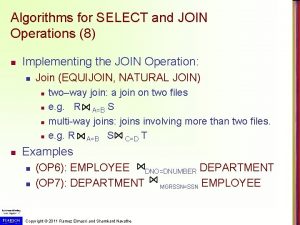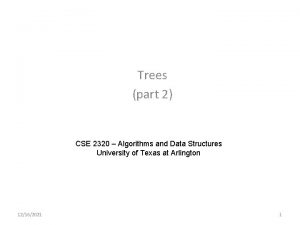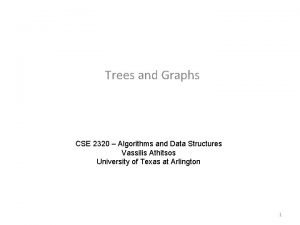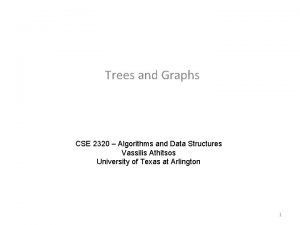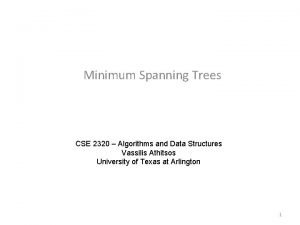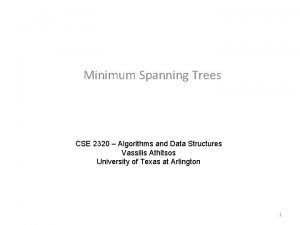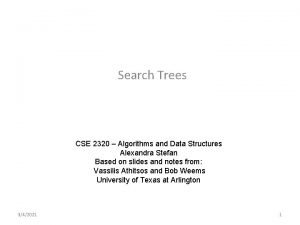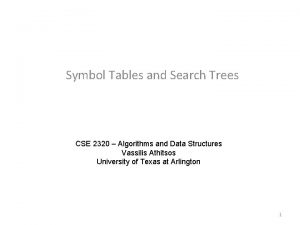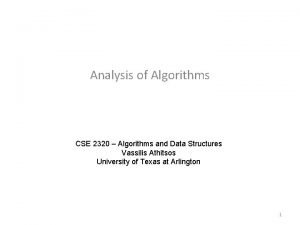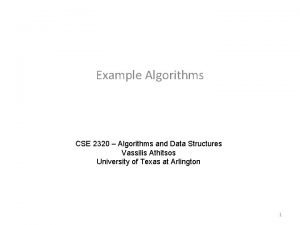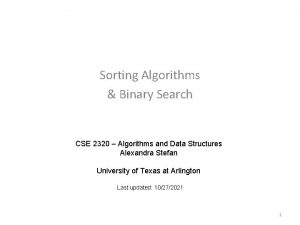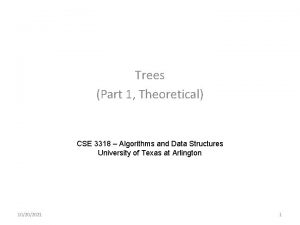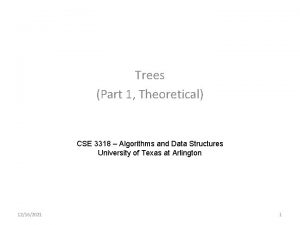Trees Part 1 Theoretical CSE 2320 Algorithms and
















- Slides: 16

Trees (Part 1, Theoretical) CSE 2320 – Algorithms and Data Structures University of Texas at Arlington 10/30/2021 1

Trees • Trees are a natural data structure for representing specific data. – Family trees. – Organizational chart of a corporation, showing who supervises who. – Folder (directory) structure on a hard drive. 2

Terminology • • Root: 0 Path: 0 -2 -6, 1 -3 -4 Parent vs child Ascendants vs descendants: – ascendants of 3: 1, 0 // descendants of 1: 5, 3, 4 • Internal vs external nodes (non-terminal vs terminal nodes) • Leaves: 5, 4, 6, 7 • M-ary trees (Binary trees) 5 • General trees • Subtree 0 1 2 3 6 4 7 3

Terminology • If Y is the parent of X, then X is called a child of Y. – The root has no parents. – Every other node, except for the root, has exactly one parent. • A node can have 0, 1, or more children. • Nodes that have children are called internal nodes • Nodes that have no children are called external nodes, or leaves. 4

M-ary Trees - Worksheet • An M-ary tree is a tree where every node is either a leaf or it has exactly M children. • Example: binary trees, ternary trees, . . . 0 0 1 5 1 2 3 6 7 4 Is this a binary tree? 2 6 7 Is this a binary tree? 5

M-ary Trees - Answers • An M-ary tree is a tree where every node is either a leaf or it has exactly M children. • Example: binary trees, ternary trees, . . . 0 0 1 5 1 2 3 6 7 4 This is not a binary tree, node 3 has 1 child. 2 6 7 This is a binary tree. 6

Types of binary trees Perfect tree • Perfect – each internal node has exactly 2 children and all the leaves are on the same level. – E. g. ancestry tree (anyone will have exactly 2 parents). • Full – every node has exactly 0 or 2 children. – E. g. tree generated by the Fibonacci recursive calls. – Binary tree. • Complete tree – every level, except for possibly the last one is completely filled and on the last level, all the nodes are as far on the left as possible. – E. g. the heap tree. – Height: and it can be stored as an array. Reference: wikipedia (https: //en. wikipedia. org/wiki/Binary_tree) Complete tree 7

Complete Tree – All levels are full, except possibly for the last level. – At the last level: Good • Nodes are on the left. • Empty positions are on the right. – There is “no hole” 9 Bad Bad 1 7 2 3 2 8 4 1 1 9 10 5 5 4 5 6 3 4 11 12 3 1 3 7 13 8

Worksheet • Self study: Give examples of trees that are: – – Perfect Full but not complete Complete but not full Neither full not complete 9

E 1 Worksheet 7 For each tree, say if it is full, complete or perfect. E 2 5 1 5 3 E 4 3 3 5 5 5 9 4 5 6 5 9 8 7 5 5 5 E 5 9 5 5 1 5 3 3 5 5 5 1 1 3 5 3 1 4 5 7 2 2 5 E 3 5 5 3 5 9 7 9 2 1 1 4 0 10

E 1 Answers E 2 3 5 1 7 3 2 1 5 3 5 9 3 5 6 5 5 5 5 9 Neither full, 4 nor complete 8 7 5 5 5 E 5 9 5 5 5 1 5 3 3 5 Full, not complete 3 5 5 1 7 5 Neither full, nor complete 3 4 5 5 E 4 2 5 5 E 3 5 5 3 9 Complete, not full 7 Perfect 7 For each tree, say if it is perfect, full or complete. 9 2 1 1 4 0 11

Terminology - Worksheet • • The level of the root is defined to be 0. The level of each node is defined to be 1+ the level of its parent. The depth of a node is the number of edges from the root to the node. is equal to the level of that node. ) The height of a node is the number of edges from the node to the deepest leaf. (Treat that node as the root of a small tree) (It A Node level depth height A B B C C Practice: - Give the level, depth and height for each of the red nodes. - What kinds of tree is this (perfect/full/complete)? ___________ - How many nodes are on each level? _________________ 12

Terminology - Answers • • The level of the root is defined to be 0. The level of each node is defined to be 1+ the level of its parent. The depth of a node is the number of edges from the root to the node. is equal to the level of that node. ) The height of a node is the number of edges from the node to the deepest leaf. (Treat that node as the root of a small tree) (It level A 0 Node level depth height A 0 0 3 B 2 2 1 2 C 3 3 0 3 For any node, depth + height = tree height 1 B C Practice: - Give the level, depth and height for each of the red nodes. - What kinds of tree is this (perfect/full/complete)? ____perfect______ - How many nodes are on each level? ____1, 2, 4, 8 _________ 13

Perfect Binary Trees A perfect binary tree with N nodes and height h, has: • leaves (half the nodes are on the last level) • internal nodes (half the nodes are internal) • Height : Level Nodes per • Levels : (= lg(N+1) ) level In the other direction: N = 2 h+1 -1 1 2 4 3 6 5 7 . . . Sum of nodes from root up to this level 0 20 (=1) 21 – 1 (=1) 1 21 (=2) 22 – 1 (=3) 2 22 (=4) 23 – 1 (=7) … … i 2 i … … h 2 h 2 i+1 – 1 2 h+1 – 1 14

Properties of Full Trees • A full binary tree (0/2 children) with P internal nodes has: – P+1 external nodes. – 2 P edges (links). – height at least lg P and at most P: • lg P if all external nodes are at the same level (perfect tree) • P if each internal node has one external child. 15

Proof Prove that a full tree with P internal nodes has P+1 external leaves. • Full tree property: • What proof style will you use? Can you prove such a relation for 3 -trees? 4 -trees? 16
 Used kla-tencor flx-2320
Used kla-tencor flx-2320 Part whole model subtraction
Part whole model subtraction Unit ratio definition
Unit ratio definition Brainpop ratios
Brainpop ratios Technical object description example
Technical object description example Parts of a pub
Parts of a pub The part of a shadow surrounding the darkest part
The part of a shadow surrounding the darkest part Part to part variation
Part to part variation Computational thinking algorithms and programming
Computational thinking algorithms and programming Design and analysis of algorithms syllabus
Design and analysis of algorithms syllabus Professor ajit diwan
Professor ajit diwan Association analysis: basic concepts and algorithms
Association analysis: basic concepts and algorithms Fftooo
Fftooo Princeton data structures and algorithms
Princeton data structures and algorithms Data structures and algorithms tutorial
Data structures and algorithms tutorial Algorithms for select and join operations
Algorithms for select and join operations Algorithms and flowcharts
Algorithms and flowcharts















